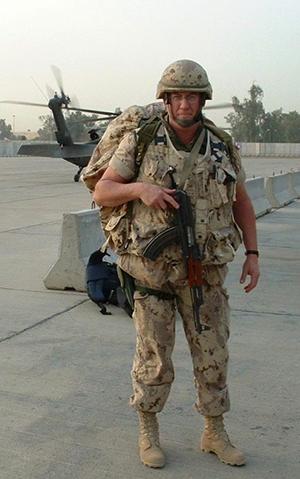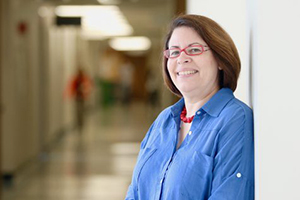Invisible Wounds
By: Paul Mayne
 Canadian Armed Forces Maj. Ronald Miller
Canadian Armed Forces Maj. Ronald Miller
Canadian Armed Forces Maj. Ronald Miller is working on healing himself.
In 1971, Miller enlisted as a young infantry private in the 1st Battalion, Royal Canadian Regiment, later becoming an officer in the Royal Canadian Artillery. He served a tour in Germany during the Cold War then reoriented his career toward peacekeeping missions, with seven deployments to a variety of conflict zones.
“Through the years, I was exposed to the kind of death and destruction that can be rather difficult from a psychological standpoint,” he said. It was during a NATO military exercise in the U.K. in 2016 when he began experiencing horrible nightmares – every night.
“I just wasn’t myself. I could see a significant change in my personality that just wasn’t me,” he said. “The older I got, the less I was able to suppress those experiences. I knew I needed to seek help.”
Veteran Affairs Canada referred Miller to the Operational Stress Injury Clinic at Parkwood Institute. There, he was officially diagnosed with post-traumatic stress disorder (PTSD) and learned about the work of Dr. Ruth Lanius, Professor with the Department of Psychiatry at Schulich Medicine & Dentistry.
Dr. Lanius’ research uses advanced imaging technologies to study differences in brain activity and neural connections between healthy individuals and those with different subtypes of PTSD. She established the Traumatic Stress Service and the Traumatic Stress Service Workplace Program at London Health Sciences Centre, both specializing in the treatment and research of PTSD and related disorders.
 Dr. Ruth Lanius, Professor Psychiatry
Dr. Ruth Lanius, Professor Psychiatry
The Service helps individuals, aged 18 to 64, who have experienced acts of violence (personal or witnessed); emotional, physical and/or sexual abuse; severe neglect; catastrophic events, such as motor vehicle accidents, or natural disasters; and war-related trauma. Because of their experiences, these individuals suffer from vivid, distressing memories, nightmares, intrusive memories, anxiety and/or panic, depression, anger and/or irritability, shame and guilt, low self-esteem, or self-destructive behaviour.
The Service’s research component uses neuroimaging to demonstrate the effects of trauma on the brain.
Dr. Lanius recently received the 2019 Banting Award for Military Health Research from the Canadian Institute for Military and Veteran Health Research in recognition of this work.
“One of the core symptoms of PTSD is that the traumatic memory is not remembered, but is actually relived. People will have flashbacks of an experience where they will feel they are actually back at the scene of that trauma, re-experiencing what they felt at that time,” said Dr. Lanius, the Harris-Woodman Chair in Psyche and Soma at Schulich Medicine & Dentistry and a Scientist at Lawson Health Research Institute.
“The horror of the shock can happen at any time. In the day, at night during their dreams. They are re-living the events and they have no control over it,” she said. “It often comes after being exposed to triggers in the environment. It could be sounds, smells, something you see. Sometimes you are aware of it and sometimes you’re not.”
There are different severities and subtypes of PTSD. Dr. Lanius’ research group has been instrumental in identifying the dissociative subtype. Recently added to the DSM-5, this subtype is characterized by a feeling of ‘de-realization’ by the sufferer – the feeling that one’s external surroundings are unreal, dreamlike or distorted.
By studying brain activity and connectivity in PTSD patients, Dr. Lanius uses biomarkers to accurately diagnosis different subtypes. This is an important qualifier, she explained, as the clearer the understanding of the subtype, the more personalized the treatment can be.
“We can actually predict with a resting stage scan who is going to have what type of PTSD with a 92 per cent accuracy,” she said. “They present themselves differently. The future really lies in that personalized medicine.”
In one study, Lanius examined patterns of brain activity for those with a ‘moral injury,’ an intense feeling of shame or guilt that can sometimes affect veterans with PTSD.
“Sometimes you’re involved in situations you don’t have control over, but you feel responsible for,” said Miller, who is managing his PTSD through a combination of therapies. “You wonder, ‘Could I have done something differently?’”
Being part of the research has been a rewarding experience for Miller. While talking about incidents that trigger his PTSD inside an MRI can be daunting, he understands that what he does today will help someone dealing with PTSD tomorrow.
“My biggest fear was giving up the things I love. I’ve been a soldier since day one – and I’m sure I will be until the day I die. It’s important we come up with solutions to ensure our veterans receive proper care. Through research, we can tailor treatment to the individual rather than looking for a broad-brush solution that might not suit everyone.”
— Major Ronald Miller
Dr. Lanius is hopeful she can be part of that solution.
“Neuroimaging is about making the invisible visible,” she said. “The brain is a fascinating organ. We learn significantly more and more every day – and we also learn how little we still know. But continually learning more it helps us to understand and develop new and better treatments.”








